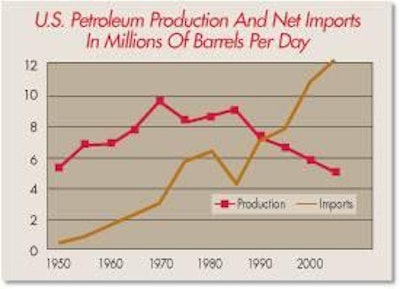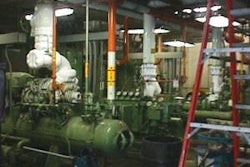
At one time, stills were hidden in the mountains of Appalachia and operated by the light of the moon to avoid Federal "revenuers." The revenuers were enforcing a law signed by George Washington that placed a 9-cent-per-gallon tax on the production of alcohol. In today's dollars that would be $1 per gallon. A still found to be operating without paying the tax was smashed to pieces. This unpopular law led to the Whiskey Rebellion of 1794 where an army of 13,000 soldiers was needed to put down the rebellion.
A time traveler from that era would be mystified by the current status of moonshine. Billions of gallons are now being produced in plain view during the day. Even more astonishing the government contributes 51 cents a gallon, and both major political parties compete with each other to show how much they love moonshine by mandating ever larger amounts of production. What was once prohibited is now compulsory.
The modern compulsory moonshine (also known as ethanol), although identical chemically to the 1794 version, is used in a different manner. While 18th century moonshine fed addiction to whiskey, 21st century moonshine feeds addiction to energy.
Why this change of heart toward moonshine? It all has to do with the high cost of oil, the dependence of the USA on imported oil and the possibility that oil supplies around the world are becoming depleted.
Substitute For Oil?
Whether or not the world is running out of oil is, of course, controversial. One idea, which gained currency in the last several years, is the Hubbert Peak Theory named after the American geophysicist Marion King Hubbert. In this theory, which was developed in 1956, the rate of petroleum production for any given geographical area, from an individual oil field to the planet as a whole, tends to follow a bell-shaped curve, rising rapidly, reaching a peak and then falling at a rate somewhat slower than it rose. Peak Oil refers to a singular event, the peak of the entire planet's oil production. In 1956, Marion Hubbert predicted that 2006 would mark peak world oil production. It is already clear that 2006 was not the peak. Nevertheless, some suggest he may have been off by only 10 years and that the peak will arrive in 2016.
Something that looks a lot like a Hubbert Peak is a graph of U.S. oil production. As can be seen in the graph, production in the USA peaked in 1970 at nearly10 million barrels a day (10 years after Hubbert predicted it would) and has fallen by 50 percent to about 5 million barrels a day now. Falling production combined with increased use has led to rapidly rising imports. Net imports are now more than 12 million barrels a day. That is the situation the USA finds itself in at this moment.
What Is To Be Done?
It is in the context of falling crude oil production, rising use of oil and soaring imports that the widespread support for ethanol becomes understandable. The production of ethanol reduces the amount of imported foreign oil, brings jobs to rural areas, is politically popular with voters and makes crop farmers happy. Ethanol is popular with both major political parties. Ethanol is seen as a homegrown solution to the energy crisis that brings more wealth to the Midwest Corn Belt and less wealth to certain other places in the world.
What could possibly be wrong with ethanol? Although the benefits of ethanol are undeniable, there are unintended consequences of suddenly shifting a massive amount of food from use by people and livestock to use by automobiles and trucks. The most important unintended consequence is an increase in the cost of producing food.
The impact of U.S. ethanol policy on world food prices is magnified by the speed and size of the ethanol boom. The increase in the use of corn for ethanol in the USA is currently doubling annually. Last crop year, the increase was 250 million bushels, this year the increase is 500 million bushels. Next crop year, the increase will be one billion bushels. By next year, the total use of corn for ethanol will approach 30 percent of the entire U.S. crop. This doubling and redoubling of the increase in corn use by ethanol has produced an unprecedented demand shock to the world agricultural system. The price of corn is about 75 percent higher than last year, and the higher price of corn has consequently increased the price of all other grains worldwide.
Crop Planting Intentions
Ethanol supporters suggest that massive increases in corn production around the world will offset the increase in use of corn for ethanol. Ethanol critics are skeptical. It will not take long before the truth of the matter will emerge one way or the other. One highly anticipated clue to future prices was the USDA crop planting intentions report of March 30th.
The report showed that 12 million additional acres of land are likely to be planted to corn this year. The total number of acres dedicated to corn (90 million acres) will be the highest since 1944. This number appears to be high enough to provide some relief for high corn prices. Nevertheless, a short crop caused by a drought could still rocket corn prices up to high levels. Volatility in corn prices is almost assured this year.
Potential Trouble Spots
The effects of rising prices will be felt differently in different countries. Countries that are large net importers of grain and who have a large portion of low-income citizens may be headed for domestic turmoil and food riots. Countries that would fall into that category include several in Latin America, the Middle East and Asia.
The cost of chicken. Even without the demand shock of ethanol, the cost of grain was destined to rise due to the fact that fossil fuels used in the production of feed ingredients represent a significant portion of the total cost of producing grains. In addition, the production of chicken meat uses a fair amount of energy (think hatchery, brooding, processing plants and transportation). The table shows an average U.S. cost of producing chicken meat around the turn of the century and the cost now. The increase, 20 percent, represents the combined effects of a doubling of the cost of energy plus higher grain costs due to ethanol. The cost of chicken production has risen by approximately 20 percent in all parts of the world.
The inevitable consequence of increasing cost is higher prices and the reduced ability of the world's population, particularly low-income consumers, to purchase chicken meat.
Bird Flu And Ethanol
Consumer confidence problems associated with bird flu reduced the annual increase in the world production of chicken meat in the last few years. This year there has been a rebound in the production and consumption of chicken because of increased consumer confidence. As a result, there are contradictory forces in the market at the moment with the rebound from bird flu stronger than the depressing effects of higher prices. The rebound from bird flu will be held back somewhat by the effects of higher chicken prices.
The current rapid increase of the use of corn for ethanol is clearly not sustainable. At some point, the increase in the use of corn for ethanol must slow down either from lower oil prices, higher corn prices, a change in U.S. policy or a combination of the three.
Increased corn production brought about by higher corn prices will be significant around the world. Therefore, in the long run corn prices are likely to moderate. There is, however, considerable danger of a spike in prices this year to record levels if there is a drought in the USA this summer.





.jpg?auto=format%2Ccompress&fit=crop&h=167&q=70&w=250)











